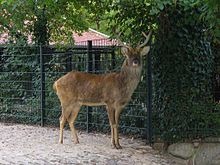澤鹿屬
澤鹿屬(學名:Rucervus)也稱沼鹿屬,是偶蹄目鹿科鹿亞科的一屬,[1]本屬現存一種,即沼鹿(Rucervus duvaucelii)。過去坡鹿(Panolia eldii)也屬於本屬,[2][3]但是基因研究結果表明坡鹿應歸入獨立的坡鹿屬(Panolia)[4][5]或者歸入鹿屬(Cervus)。[6]
| 澤鹿屬 | |
|---|---|

| |
| 沼鹿(Rucervus duvaucelii) | |
| 科學分類 | |
| 界: | 動物界 Animalia |
| 門: | 脊索動物門 Chordata |
| 綱: | 哺乳綱 Mammalia |
| 目: | 偶蹄目 Artiodactyla |
| 科: | 鹿科 Cervidae |
| 亞科: | 鹿亞科 Cervinae |
| 族: | 鹿族 Cervini |
| 屬: | 澤鹿屬 Rucervus Hodgson, 1838 |
| 異名 | |
| |
另有原分布於泰國的熊氏鹿(Rucervus schomburgki)一般被認為在20世紀30年滅絕,但有學者認為至少在20世紀90年代熊氏鹿仍有可能處於活躍狀態。有人認為在寮國偏遠地區熊氏鹿仍有很高的概率存在一小部分種群。[7][8][9]
下屬物種
編輯本屬包括以下物種:
參考文獻
編輯- ^ 劉匯,董依萌,王磊,周永娜,邢秀梅,楊福合. 中国鹿类动物分类及系统进化研究进展[J]. 野生動物學報. 2017, 38 (3): 514–523 [2021-06-19]. (原始內容存檔於2021-06-30).
- ^ Rucervus Hodgson,1838. GBIF. Copenhagen, Denmark: GBIF Secretariat. [2021-06-19].
- ^ Rucervus Hodgson,1838. ITIS. [2021-06-19].
- ^ Groves (2006). The genus Cervus in eastern Eurasia. European Journal of Wildlife Research 52: 14–22
- ^ Groves, C. and Grubb, P. 2011. Ungulate Taxonomy. The Johns Hopkins University Press, Baltimore, USA.
- ^ Pitraa, Fickela, Meijaard, Groves (2004). Evolution and phylogeny of old world deer. Molecular Phylogenetics and Evolution 33: 880–895.
- ^ 1991年的新鲜鹿角照片 暗示灭绝50年的熊氏鹿或仍生活在老挝. 搜狐網. [2021-06-19]. (原始內容存檔於2021-06-28).
- ^ Amanda Morris. Evidence suggests rare deer lived 50 years beyond ‘extinction’. Northwestern University. [2021-06-19]. (原始內容存檔於2021-10-15).
- ^ Schroering, G. B., & Galbreath, G. J. Evidence of late survival of Schomburgk's deer Rucervus schomburgki in central Laos. Journal of the Bombay Natural History Society. 2019, 116: 49–50. doi:10.17087/jbnhs/2019/v116/142873.
- ^ G. B. Schroering and Gary J. Galbreath. 2019. Evidence of Late Survival of Schomburgk's Deer Rucervus schomburgki in Central Laos. Journal of Bombay Natural History Society (JBNHS). 116. DOI: 10.17087/jbnhs/2019/v116/142873